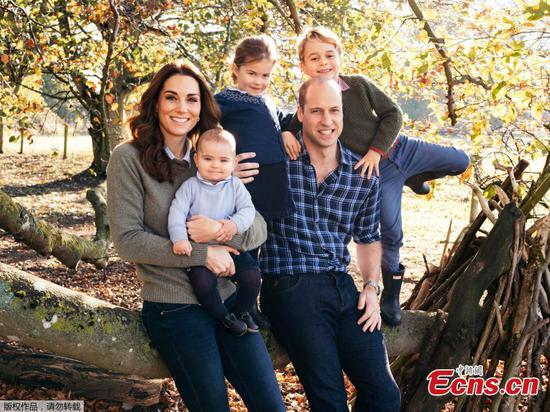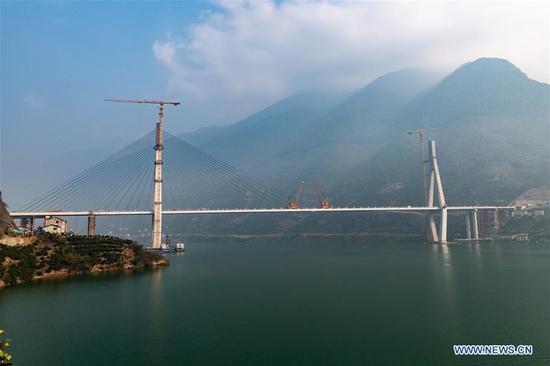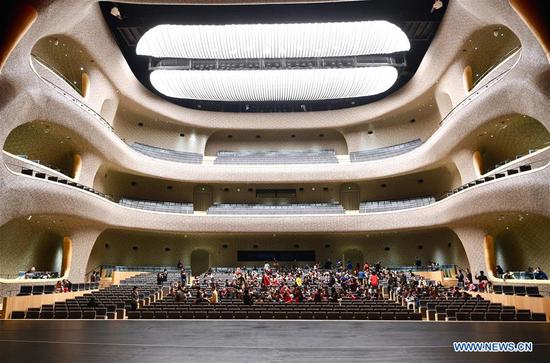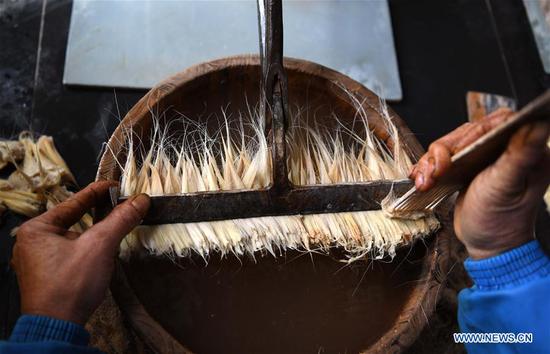
An employee performs welding operations at a private company in Zibo, Shandong province. (Photo/Xinhua)
China needs to lower its annual economic growth target in next year, financial news outlet Yicai reported Monday, citing experts.
The country's gross domestic product growth will ease to 6.3 percent in 2019 from this year's 6.6 percent, and China will set its next year annual growth target between 6 percent to 6.5 percent said Zhang Jun, economist with Morgan Stanley Huaxin Securities.
The 6.5 percent growth shows the country will maintain its economy growth, and the 6 percent growth indicates the country will make room for restructuring, Zhang said.
China will keep economic growth at a reasonable level, a meeting held by the Political Bureau of the CPC Central Committee said on Dec 13.
Utilizing the reasonable level to manage economic growth will be conducive to promote reforms to substantial level and avoid short-term economic fluctuation to disturb the reforms, said Yang Chang, analyst at Zhongtai Securities.
In 2019, China's natural rate of economic growth will be around 5.5 percent, and after macro-control, the economic growth will reach 6.2 percent, said Su Jian, an economist with Peking University.
This year, the sustained pullback on the manufacturing PMI and profits of industrial enterprises will surpass industrial activity; the adverse effects from trade tension between China-US will incarnate next year; although the tax reduction policy will support the consumption, the long-term home loan will restrict the consumption to expand, Su said.
Next year, the contribution of investment to GDP will remain flat from 2018 due to the upswing in infrastructure investment growth, manufacturing investment will maintain a high growth, and the growth of the real estate investment will slip a bit, Su added.
Consumption
There will be no change in consumption upgrading in China, but the structural is changing among the process of the consumption upgrading; Chinese people are turning to service consumption, after they were satisfied by real goods consumption, said Zhang Jun.
The growth of retail sales will decline to around 8.9 percent next year; in order to maintain the consumption, the government needs to announce more policies to loosen consumption, Zhang said.
In the long-term, the government needs to invest more on social public products such as education, healthcare and elderly, aims to lower Chinese people's defensive deposit to solve people's worries to consumption, Zhang added.
Su Jian said China's retail sales will increase 7.8 percent year-on-year on 2019 as the marginal utility of consumption will trickle down, as well as the influence of social security and the individual income tax reform have not yet been felt.
Moreover, the fixed-asset investment will increase 5.4 percent year-on-year in 2019, Su predicted.
In 2019, the fixed-asset investment growth will be difficult to realize a big jump under the background of overcapacity reducing and restructuring; the enterprises' investment will be effected by enterprise short-term cost fluctuation from the social security and the individual income tax reform; Some uncertainties such as environment policies and social security reform will also add pressure to enterprises' investment, Su added.
Trade
The growth of export and import will decline from 11.3 percent and 18.5 percent to 5.2 percent and 6.3 percent in 2019, as well as the trade surplus will narrow to $350 billion, the contribution of net export to GDP growth will be at -0.8 percent, Zhang Jun predicted.
Due to the trade surplus narrowing, and the global liquidity tightening led to FDI, or foreign direct investment declining, the funds outstanding for foreign exchange will shrink next year, Zhang said.
In order to avoid the funds outstanding for foreign exchange shrinking to lead basic currency to fall, China's central bank will reduce the reserve requirement ratio to balance domestic liquidity, Zhang added.
Su Jian said the growth of export and import will be at 14.4 percent and 6.2 percent in 2019, as Chinese people's consumption structure is improving and upgrading, and the expanding import policy is carrying out, the growth of import will increase in 2019.
However, the growth of import in 2019 will be less than it in 2018, and the trade surplus will be $400 billion in next year, Su added.
Shen Jianguang, chief economist JD Finance, said China's annual economic growth target in 2019 is essential to come down to around 6 percent growth as that's better for bottom-line thinking and will give more space to China for reforming.


















































